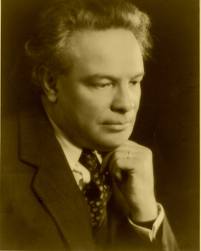July 9, 2018. Respighi, Diamond, Cliburn. Ottorino Respighi, an important Italian composer of the 20th century, was born on this day in 1879. We’ve written about him on a number of occasions, for example here and here. While his best-known compositions are the so-called “tone poems,” the Fountains of Rome and the Pines of Rome in particular, Respighi also wrote quite a bit of chamber music. Here, for example, is the Violin sonata in B minor, which Respighi completed in 1917.  A three-movement work in a late-Romantic style, it’s performed by the distinguished American violinist Aaron Rosand, with the pianist John Covelli.
A three-movement work in a late-Romantic style, it’s performed by the distinguished American violinist Aaron Rosand, with the pianist John Covelli.
While Respighi was featured in several of our posts, we’ve never written about the American composer David Diamond. Diamond was born on July 9th of 2015 in Rochester, NY. His Jewish parents immigrated from Austria and Poland. Diamond studied the violin and music theory at the Cleveland Institute of Music before moving to New York to study with Roger Sessions at the New Music School. He won a scholarship to go to Paris; there, he met Ravel, Milhaud and Roussel, and the writers André Gide and James Joyce. While in Paris, he studied with Nadia Boulanger. He returned to the States at the outbreak of WWII, in 1939. The next 12 years were difficult, as Diamond didn’t have a permanent position, but productive: he wrote four symphonies and several other orchestral compositions, a violin concerto and a number of vocal pieces. In 1951 Diamond returned to Europe, this time as a professor at the University of Rome. A year later he moved to Florence, where he lived, more or less permanently, till 1965, avoiding the US of the McCarthy era.
After returning to the US, Diamond served as the chair of the composition department at the Manhattan School of Music, and as professor of composition at Juilliard. Diamond wrote mostly tonal music, well-orchestrated, dynamic, with a great sense of overall shape. This style became quite unfashionable with the advent of the Darmstadt-influenced young composers, such as Pierre Boulez, Bruno Maderna, Karlheinz Stockhausen and Luigi Nono, who wrote in the atonal and 12-tonal mode and used serialism. Diamond never recovered his popularity, even when tonal music made a partial comeback. Still, he was a masterful composer, with many students, and his name will be remembered. Here’s David Daimond’s joyous Rounds for String Orchestra. It was commissioned in 1944 by Dimitri Mitropoulos who was then the principal conductor of the Minneapolis Symphony Orchestra. Diamond composed it that same year and Metropoulos premiered it with his orchestra. In our case, Gerard Schwarz, a champion of Diamond’s music, is conducting the Los Angeles Chamber Orchestra.
Also this week, the American pianist Van Cliburn, mostly famous for winning the First Tchaikovsky piano competition in 1958, was born on July 12th of 1934. Here he plays Un sospiro, the third of Three Concert Études by Franz Liszt.
| Source: | https://www.classicalconnect.com/node/12621 |
| Website: | Classical Connect |